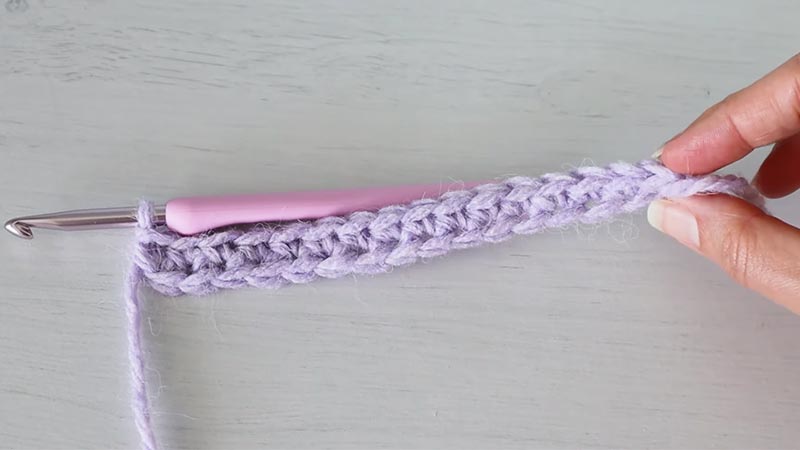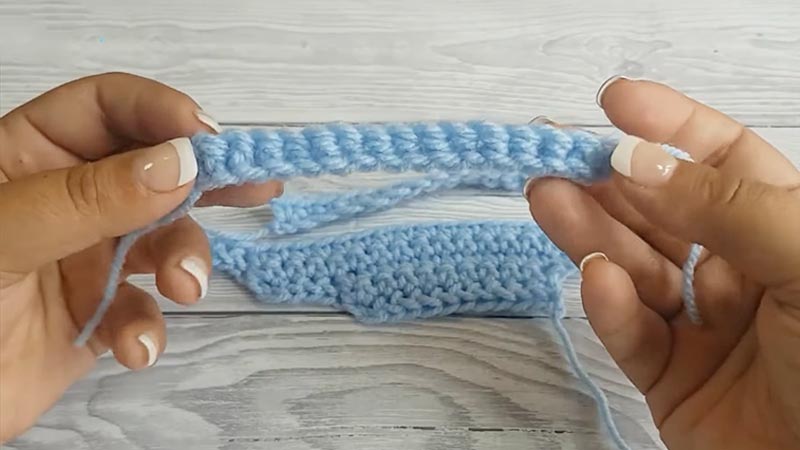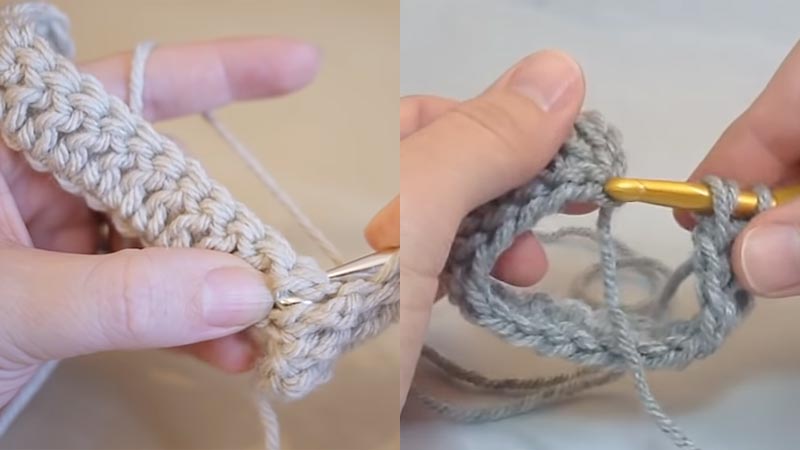In the world of crochet, the choice between a foundation stitch and a chain foundation marks a critical decision for crafters.
The foundation stitch, a technique that seamlessly integrates the initial chain and the first row of stitches, holds distinct advantages over its traditional counterpart.
This method provides a sturdier, more stable base, ensuring projects withstand wear and tear gracefully. It eliminates the common issue of uneven edges and optimizes yarn usage, making it both cost-effective and time-efficient.
This introduction delves into the compelling reasons why the foundation stitch has become a favored technique, offering a superior starting point for a wide array of crochet endeavors.

What Is a Foundation Stitch?
A foundation stitch is a fundamental technique in crochet that serves as an alternative to the traditional starting chain.
Unlike a chain, which forms a base for subsequent rows, a foundation stitch combines the initial chain and the first row of stitches into a single step.
This creates a more stable, even, and flexible foundation for the crochet project. It eliminates the need for turning chains, resulting in a polished finish without uneven edges.
This technique is particularly valuable for projects that require durability, intricate stitch patterns, or items that need to fit snugly, such as garments or accessories. It offers greater versatility and efficiency in crocheting various stitch types.
What Is Chain Foundation?

A chain foundation, in crochet, refers to the traditional method of starting a project by creating a series of chain stitches. These chains are the foundation upon which subsequent rows of stitches are built.
The chain foundation essentially forms a base row for the project, and it is from this row that crocheters work subsequent stitches.
While the chain foundation is widely used and suitable for many crochet projects, it is worth noting that some crocheters prefer alternative methods like the foundation stitch for its perceived advantages in terms of stability, even edges, and efficiency.
Why Is Foundation Stitch Better Than Chain Foundation?

The choice between using a foundation chain or a foundation stitch in crochet largely depends on the project and personal preference.
However, there are several reasons why many crocheters prefer the foundation stitch over the traditional chain foundation.
Sturdiness and Stability
By its very nature, the foundation stitch creates a more robust and secure base for your crochet work. This is particularly crucial for items that will frequently use or need to endure some wear and tear.
Blankets, for instance, benefit greatly from a sturdy foundation as they are often subjected to regular handling and washing. The added stability ensures that the stitches remain intact over time, preserving the project’s overall structure.
Eliminates the Need for Turning Chains
When using a foundation stitch, the need for turning chains at the beginning of a row is circumvented. This is a significant advantage because turning chains can sometimes lead to an uneven edge, which can be visually distracting.
With a foundation stitch, each row begins with a solid and consistent edge, resulting in a more polished and professional finish.
Saves Time and Yarn
Creating a foundation with a stitch often requires less yarn than making a long chain. This can lead to substantial savings in larger projects, especially those where yarn conservation is a priority.
Additionally, using a foundation stitch tends to be more time-efficient as it combines the initial chain and the first row of stitches into one step. This streamlined approach can significantly expedite the crocheting process.
Prevents Curling Edges
One common challenge in crochet is dealing with curling edges, especially when working on projects like blankets or scarves.
The foundation stitch produces a more flexible and balanced edge, greatly reducing curling likelihood. This ensures that your finished work maintains a neat, flat appearance.
Easier to Count Stitches
Identifying and counting stitches is essential to crochet work, particularly in complex patterns.
When working into a foundation stitch, the stitches are more distinct and easier to identify than the individual chains in a chain foundation. This makes it simpler to keep track of your stitch count and maintain the pattern accurately.
Enhanced Stretch and Flexibility
Certain projects, like garments or bags, require a level of stretch or elasticity. The foundation stitch provides a more forgiving and comfortable fit.
This is especially crucial for items that need to conform to the body, ensuring they are both functional and comfortable.
Better for Double Crochet
For taller stitches like double crochets, a foundation stitch provides a more solid and secure base to work into. This prevents the stitches from sagging or stretching, which can happen when using a chain foundation. The result is a more even and well-defined fabric.
Suitable for Complicated Stitch Patterns
Intricate stitch patterns, especially those with multiple increases and decreases, are often easier to execute when using a foundation stitch.
The firm base provides a stable platform for complex designs, allowing for a more accurate and controlled pattern execution.
Less Likely to Twist or Tangle
A foundation stitch tends to lay flatter and is less prone to twisting or tangling than a long chain.
This characteristic makes it easier to work with, especially in projects with intricate stitch patterns or requiring precise stitch placement.
Versatility
The foundation stitch is incredibly adaptable and can be employed for various crochet techniques. This includes single crochet, half-double crochet, double crochet, and even more advanced stitches.
Its versatility makes it versatile for many projects, from intricate lacework to durable blankets.
Difference Between Foundation Stitch and Chain Foundation

The foundation stitch and chain foundation are two distinct techniques in crochet, each serving as a starting point for a project.
Here are the key differences between them:
Method of Creation
- Foundation Stitch: This technique combines the initial chain and the first row of stitches into one step. It creates a stable and even base for the project.
- Chain Foundation: This is the traditional method where you begin with a series of chain stitches. These chains then serve as the foundation for subsequent rows of stitches.
Stability and Durability
- Foundation Stitch: It provides a sturdier base, which is crucial for items that will endure frequent use or need to withstand regular washing.
- Chain Foundation: While adequate for many projects, it may not be as stable as a foundation stitch, which can be a consideration for items subject to heavy wear.
Elimination of Uneven Edges
- Foundation Stitch: Eliminating the need for turning chains ensures a polished finish without the common problem of irregular edges.
- Chain Foundation: Turning chains can sometimes lead to an uneven edge, which may require additional blocking or shaping.
Efficient Use of Yarn and Time
- Foundation Stitch: Often uses less yarn and streamlines the crocheting process by combining the initial chain and first row of stitches into one step.
- Chain Foundation: Can consume more yarn, particularly in larger projects. The process involves separate steps for creating the initial chain and then working into it.
Preventing Curling Edges
- Foundation Stitch: Results in a more balanced edge, reducing the likelihood of curling, which is a common challenge in certain projects.
- Chain Foundation: This may require additional blocking or shaping to address any curling that occurs.
Ease of Stitch Counting
- Foundation Stitch: Stitches are more distinct and easier to identify than the individual chains in a chain foundation, simplifying the process of keeping track of stitch counts.
- Chain Foundation: Identifying individual chains can sometimes be more challenging, especially in complex patterns.
Suitability for Taller Stitches
- Foundation Stitch: Provides a more secure base for taller stitches like double crochets, preventing sagging or stretching.
- Chain Foundation: This may result in more sagging or stretching with taller stitches.
Complex Stitch Patterns
- Foundation Stitch: Offers a stable platform for intricate stitch patterns, allowing for more accurate execution.
- Chain Foundation: While suitable for many patterns, maintaining pattern integrity may require additional attention.
Likelihood of Tangling
- Foundation Stitch: It tends to lay flatter and is less likely to twist or tangle than a long chain, making it easier to work with.
- Chain Foundation: Chains can sometimes become tangled or twisted during the initial stages of a project.
Versatility
- Foundation Stitch: Highly adaptable, compatible with various crochet techniques, making it suitable for various projects.
- Chain Foundation: While versatile, it may require modifications for specific stitch types or patterns.
FAQs
What is a foundation stitch in crochet?
A foundation stitch is a technique that combines the initial chain and the first row of stitches, providing a sturdier and more stable base for your crochet project.
Why is the foundation stitch considered better than the chain foundation?
The foundation stitch eliminates uneven edges, offers better stability, and uses less yarn. It also prevents curling and provides a more accurate stitch count.
How does the foundation stitch save time and yarn?
It combines the initial chain and first row of stitches into one step, which can be more time-efficient.
When is the foundation stitch particularly beneficial?
The foundation stitch is especially beneficial for projects that require durability, intricate stitch patterns, or items that need to fit snugly, such as garments or accessories.
Can I use the foundation stitch for different types of crochet stitches?
The foundation stitch is versatile and can be adapted to various crochet techniques, from single crochet to more advanced stitches.
Wrap Up
The foundation stitch emerges as a superior choice in crochet for several compelling reasons. Its stability and durability create a robust base, which is crucial for items enduring frequent use. Eliminating uneven edges results in a polished finish.
This technique efficiently utilizes yarn and time, making it cost-effective and time-saving, especially in larger projects.
Its prevention of curling edges and ease of stitch counting further enhance its appeal. Versatile and adaptable, it accommodates various stitch types and complex patterns.
The foundation stitch ultimately proves itself to be a reliable and efficient method, ensuring that crochet projects look refined and stand the test of time.
Leave a Reply